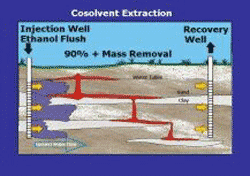Combined Treatment Technologies
Introduction
Combined or phased treatment scenarios can improve both the effectiveness and cost of groundwater remediation. Monitored natural attenuation or enhanced bioremediation is often used as a “polishing” step, following other more aggressive remedial technologies to meet regulatory requirements for maximum concentrations of contaminants in groundwater. Bioremediation uses specific microorganisms (either indigenous or applied) to transform contaminants into nonharmful chemical products. Biotechnology is used to track the rate and degree of treatment by assessing the microbial community present in the subsurface. EPA researchers are investigating the potential for combined treatment technologies as a cost-effective, less-invasive remedial option. ProductsAzadpour-Keeley, A., M.J. Barcelona, K.D. Duncan, and J.M. Suflita. The Use of Molecular and Genomic Techniques Applied to Microbial Diversity, Community Structure, and Activities at DNAPL and Metal-Contaminated Sites – Environmental Research Brief (EPA/600/R-09/103) September 2009 – Abstract Mravik, S.C., R.K. Sillan, A.L. Wood, and G.W. Sewell. (2003). “Field Evaluation of the Solvent Extraction Residual Biotreatment Technology.” Environ. Sci. Technol., 37: 5040–5049. ContactAnn Keeley
You will need Adobe Reader to view some of the files on this page. |
![[logo] US EPA](../gif/logo_epaseal.gif)
